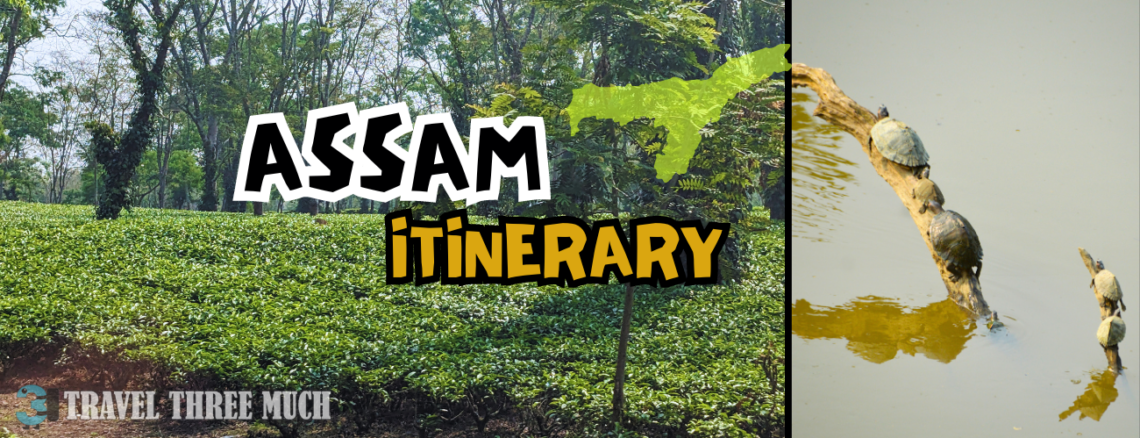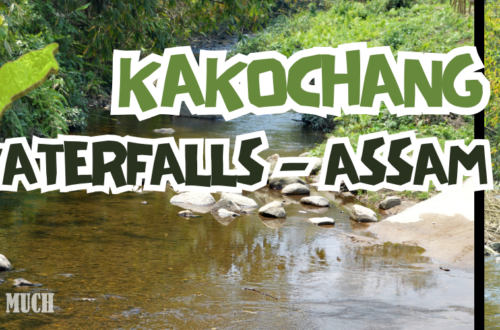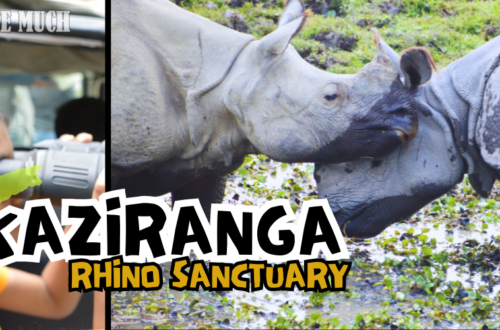
Assam Getaway: A Family Vacation Itinerary
We took a 6 day trip to Assam in the year 2023.
Below is our itinerary and the day by day map of our beautiful experience during the Bihu festival in Assam.

In April 2023, we landed at the Guwahati airport and drove down to Kaziranga, reaching our place of stay just past sundown.
We managed to catch a glimpse of what was in store for us in the next few days on the way when we spotted rhinos, wild buffaloes and swamp deer on the way to the national park.
We retired for the day after a welcoming cup of strong tea and a sumptuous dinner, all set for the next day’s safaris.

Day 1 – Assam Itinerary
Kaziranga Wildlife Sanctuary – Elephant Safari
The next morning, we ventured early in the morning into the captivating Kaziranga National Park, a UNESCO World Heritage site nestled in the northeast of India.
Renowned for its diverse ecosystems and as the home of the one-horned rhinoceros, the park offered us an extraordinary day of two safaris. The morning’s elephant safari, starting at 7 AM, provided a unique advantage.

The gentle giant allowed us unparalleled proximity to the rhinos, showcasing their remarkable composure in the presence of another wild animal. Heartwarming scenes unfolded, including a mother rhino with her adorable calf, challenging their formidable reputation. The safari also treated us to the sight of wild buffaloes and elegant storks in the marshy waters.
Kaziranga Wildlife Sanctuary – Jeep Safari
In the afternoon, the jeep safari expanded our adventure, allowing us to witness a wider expanse of the park’s biodiversity. From turtles basking in the sun to a kingfisher’s vibrant plumage, the jeep safari added new dimensions to our wildlife encounters. Unpredictable moments, like a wild elephant’s silent emergence, left us in awe.
As the day wound down, our hearts brimmed with gratitude for the privilege of witnessing nature’s unadulterated grandeur.
Our visit underscored the importance of preserving such pristine habitats for future generations. Kaziranga National Park, with its unique charm and captivating beauty, serves as a poignant reminder of the delicate yet resilient balance of life in the wild.
YOU MAY ALSO LIKE :, Kaziranga Sanctuary: Realm of the One-Horned Rhino
Day 2- Assam Itinerary
Deopahar Archaeological site
Deopahar or the ‘Hill of the Gods’ is a group of monuments about an hour’s journey from Kaziranga National Park’s Central Range gate.
The route from our stay took us on a journey where the towns we passed through were interspersed with tea estates owned by private establishments. We took a right on the road to Jorhat, at Numaligarh town to reach the Deopahar Archaeological site.
We were among the first to reach the site as it opened for the day. A board outside the site informs the visitors that the site dates from about 10th to 11th century. The structures and sculptures found here hint at a probable temple which has fallen prey to the elements over time.
A short steep trek brought us to the a small plateau with a mural of a meditating Shiva and smaller paintings appealing us to abandon plastic usage.

We stopped for a bit to take in the view and catch our breath. We noticed the tall trees had large beehives hanging from them. Our driver told us that they used to allow vehicles until this point in the past till a mishap put an end to it and now all visitors have to trek up the hill to reach the top. We made it up the final ramp with raised platforms on either side. Stones which would’ve once been a part of the temple structure are displayed on both platforms.
The ramp leads to the remains of the temple. Twin concentric rings make up the temple’s remains with the outer ring serving as an open air gallery of structures and sculptures recovered from the site.
There were recurring themes from Mahabharata, Ramayana depicted in the sculptures.
Deities from the Saivite and Vaishnavite schools feature in the sculptures. Recurring motifs such as flying nymphs serving as either lintel decoration or plinth decoration and lotus jambs reminded us of pictures of Indonesian/Cambodian temples, especially the facial features of nymphs.
Each of the nymphs had a different expression on its face and the architecture was unlike anything that we saw during the remaining part of our trip, reminding us of part South Indian temples and part Far Eastern temple architecture. We spent close to an hour at the hill but it didn’t feel that long.

On the way down, our sharp-eyed driver pointed out a Tokay Gecko to us that had come out from its home in the tree to bask in the bright sun.
He told us they were earlier being poached for traditional Chinese medicine preparations but are better protected now thanks to awareness of the local populace and the steep punishments that have been imposed by the state on offenders.
Kakochang Waterfall
Our next stop for the day was Kakochang waterfalls. We drove back towards Kaziranga and took a left off the highway past the Bokakhat Tea Estate.
It took us about an hour through villages which seemed untouched by electricity except for a few solar panels that probably powered lighting loads. We couldn’t help but wonder at the self-sufficiency of the people. We reached a barrier which is operated by the tribal village council and collects an access/parking fee.
A little ways after this barrier, we came upon our first motorable stream crossing. We’d not seen a feature like this anywhere else except on our trip to Nathu La where snowmelt flowed across the road in streams. Our driver told us that even in the heights of summer like during our visit, the waterfall never dried and this was a newly discovered destination and so was relatively pristine.
We parked the car a little ways off this stream crossing and proceeded for the last stretch on foot.
It was a one kilometer trek where we had the option of either wading across stream crossings or taking foot over bridges. Since we didn’t want to make the interiors of the car damp, we chose the foot over bridges but if there are kids and you don’t mind getting the inside of your vehicle wet or if you can wait long enough to dry off, walking across the streams is the more fun option!
It was a warm day and we were beginning to wonder how much longer the trek was to the waterfall as signage was minimal, especially when we came across a 300 m long over bridge poetically referred to as the ‘Sky Walk’.

As the waterfall came into view, we felt the trek was definitely worth it. The water was cool and clear.
The waterfall was a group of three different cascades, each having three levels.
The place where the water reached the ground was pretty deep and a rope was strung to prevent folks from going there. Some locals had an inflatable canoe that they were rowing about in and diving from into the pool. It was fun to watch.
We splashed our feet about for a while and then made our way back to the car, fully refreshed for the next stop.
Orchid Biodiversity Park
We made our way to the Orchid Biodiversity Park for lunch.
As it was Bohag Bihu time (the Assamese New Year), there were dance shows of about 5 minutes each that were spaced 20 minutes apart.
We got to see the Sattriya Dance first. This dance form is one of the 9 classical dance forms of India recognized by the Government of India’s national academy of performing arts – The Sangeet Natak Akademi.
We were mesmerized by the grace of the dancer as he performed the legend of the 10 avatars or incarnations of Vishnu.

Up next was the famous Cheraw dance of Mizoram. This involved a group of 4 men that held split bamboo staves in a grid. A single drummer set the rhythm for the dancers.
The women entered and exited the grid flawlessly in step with the beat of the drum, which went up and down in tempo throughout the performance. This was followed by a troupe of Mishing (also called as Mising) tribesmen and women who performed the Ali Ai Ligang dance.
Finally, there was a troupe of Bihu dancers who performed the traditional dance, with such joy on their faces that we in the audience couldn’t help but get into a festive spirit with them.
After a scrumptious lunch of Bihu thali, we took in the other sights in the park – a museum that showcased the traditional musical instruments, a children’s play area, a herbal garden, a museum with the antiques used by Assamese royalty (Ahom dynasty) including the world famous Majuli masks, and the important historic and tourist sites in the seven sisters and one brother that make up the North East Indian states, a museum that had a functional loom used to weave Muga silk sarees with the traditional Assamese motifs.
The highlight of the park was a conservatory showcasing the different types of orchids, in particular the beautiful foxtail orchid or kopou, which is an essential part of the hair decor in the Bihu dances, and is also the state flower of Assam.
Just outside the park is a series of shops which sell souvenirs and the world famous organic Hathikuli tea.
Day 3 – Assam itinerary
We returned back to Guwahati from Kaziranga, with a few stops for tender coconuts and to shop for some woven Jaapis on the way.
Day 4 – Assam itinerary
Guwahati Zoo
Our first stop the next day was the Guwahati zoo. It was the first time we got to hear and see hoolock gibbons in their enclosure, and there were no doubts as to where they got their name from!

The other main draws were the leopards, royal Bengal tigers, black panthers, black bears, hippos, and a large aquatic aviary which had pelicans, adjutant storks and other water birds.
We had a lunch at the Bibliophilia Cafe, which serves up delicious fare in a setting with books that are in various genres. We then went to the Mahabahu Brahmaputra River Heritage Center.
Brahmaputra River Heritage Museum
This is a large pedestrian-only park with many art installations, a cafeteria, a Starbucks, an open amphitheater and the erstwhile Deputy Commissioner’s bungalow, which has been converted into a museum of Ahom artifacts, musical instruments and antiques from the colonial times.
The location of this heritage museum is the hillock from where the legendary Lachit Borphukan surveyed the river and devised the strategy in the naval battle with the Mughal navy in which the attackers were decisively defeated.
Visitors should keep in mind that food items are prohibited to be taken into the museum area because of the cafeteria and Starbucks that are in the campus.
Guwahati Ropeway
We then made our way to the Guwahati ropeway, which connects the two banks of the Brahmaputra. This is the longest ropeway in India and connects the Southern and Northern parts of Guwahati on the banks of Brahmaputra.
The ropeway offers breathtaking vistas of the Peacock Island housing the Umananda Temple, which also happens to be the site of a failed effort at conserving the Golden Langur, with the last remaining individual on the island dying in 2020, 36 years after they were introduced there.
The ropeway helps understand the width of the river and why it remains a lifeline across the varying geographies of such a large area spanning several nations.

Day 5 – Assam itinerary
Guwahai War Memorial
Our next top was the Guwahati War Memorial. It’s a part of a small park with monuments dedicated to the various conflicts in India and the rest of the world where Indians, and in particular Assamese, have paid the ultimate price and laid down their lives in service of their country.
There are static displays and scale models of various armaments used in these wars, such as aircraft, missiles, tanks, etc. There’s a sculpture depicting Lachit Borphukhan urging on his soldiers to victory in the Battle of Saraighat, where the Rajputs and Mughals were decisively defeated in naval battle by the Ahoms.
The museum also has a list of Param Vir Chakra awardees, panels showing key moments from the rise of Assamese dynasties such as the Koch, the Ahoms, etc. on to the two world wars and the Sino-Indian war of 1962.
Assam State Museum
We walked to the Assam State Museum, a short distance away from the War Memorial. Other than a couple of sections which were being renovated, all the other sections were open. There were many examples of sculptures excavated in and around Assam.
The sculptures had recurring motifs such as Mahishasuramardhini, Vishnu, Shiva, ascetics, etc. There are also scenes of the local version of theatre using masks constructed from clay and bamboo, from the island artisans of Majuli.
There are also full scale village homes and the vessels used in such rural dwellings. It was interesting to see the xorai or sorai, a betel nut tray with stand and a hemispherical cover with a conical ornament on the cover, made from brass. Also on display were old manuscripts written and exquisite paintings on the barks stripped from a tree, known as the Sanchi tree.
Day 6 – Assam itinerary
Pobitora Wildlife Sanctuary
The next day, we set off to the Pobitora Wildlife Sanctuary, situated about 2 h driving from Guwahati city.
Pobitora is a wetland reserve with more than 100 rhinos. It is mandatory to book online tickets for the elephant and jeep safaris. In our case, the day we visited also happened to be the day of the Bihu festival. We were assured that the sanctuary would remain open, despite it being the start of the Assamese new year.
When we reached the sanctuary however, there was not a jeep in sight for the safari and we got to know that the drivers had taken the day off because of the festival and there was a scramble to get some drivers at short notice. We spent the time walking over a suspension bridge that would lead to the start point of the elephant safari.

After about an hour’s wait, a driver with a jeep appeared and once our tickets were verified, we were on our way.
We saw a few parrots and wild elephants as we made our way deeper into the reserve. We got a chance to get much closer to the rhinos here than even the elephant and jeep safaris in Kaziranga, and they turned out to be such gentle giants if left unbothered!
We also saw some whistling ducks which froze like statues when we made any noise, a few horses (our guide/driver gave us an interesting origin story – a pair of horses had bolted from a neighboring village into the sanctuary, but the owner was forbidden from recovering the horses back. The horses have now become a herd!), adjutant storks and swamp deer.
We found a pleasant surprise waiting from our hosts when we reached the homestay. They gave us a Bihu meal with doi-chira (flattened rice with curd and jaggery), poli (unleavened wheat bread), til pitha (rice flour rolls filled with sesame sweetened by jaggery), khar (greens-based alkaline palate cleanser) and dal.
It was a nice gesture from them to include us as well in their celebrations.
On this trip, we got to taste the different variants of tea, a drink that we are very fond of – blue tea made from the petals of butterfly pea plant, red tea also called Ronga Saah which had a delicate flavour.
Assam’s famous masala tea and a franchise of Maharashtra’s famous Yewale Amrut Tulya chain of tea shops in Guwahati. It was an interesting experience to sample the different tea options, and it helped us find a close match to the Assam tea we loved, when we were back home!



